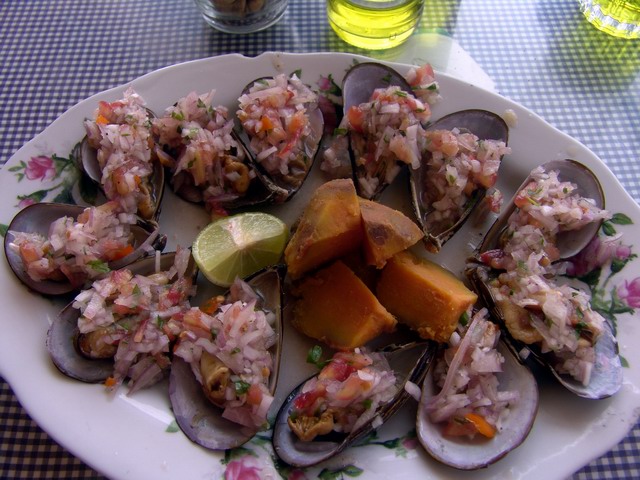5.25.2006
High on Peru

Choros a la chalaca (mussels marinated in lime juice) is typical eats on the coast of Peru.
Highlights from a recent Washington Post article by Walter Nicholls on Peruvian cooking...
High on PeruRead the full article (registration required).
With Its Mix of Worldly Flavors, the Country's Cuisine Could Be the Next Thai
Take one part Incan and one part Spanish. Mix well. Add influences of African, Chinese, Japanese and Italian. What do you get? Peruvian -- the cuisine that legendary French chef and culinary writer Auguste Escoffier called one of the best in the world -- after only French and Chinese. Considering its status, it's also a cuisine that has been relatively overlooked. Until now.
Alejandro Riveros, head of public diplomacy for the Embassy of Peru, has made it his mission to promote the sophistication, innovation and most importantly, taste, of foods from back home. [snip] Riveros believes Peruvian food is unique because "of the more than 100 climate zones in the world, we have 84." Peru has "every different ecosystem, from desert to jungle to snow-capped peaks and down to the sea where the cold currents from the South Pole are great for seafood."
The staples of Peruvian cuisine -- potatoes, yucca, corn and chili peppers -- were provided by the Incas centuries ago. Spanish conquistadors who arrived in the 16th century brought citrus fruit, wheat, rice, cattle and pigs as well as European-style desserts. Africans introduced spicy, vinegar-marinated beef and fish on skewers.
Then came the Chinese, who came to build railroads. They introduced soy sauce and fresh ginger as well as stir-fry cooking. Japanese arriving in the early 1900s to work on sugar and cotton plantations brought their love of seafood and techniques for preparing it simply and beautifully.
Tags: Peru, cuisine, cooking, cocina peruana, Incas, African, Chinese, Japanese, Italian, Auguste Escoffier, Alejandro Riveros, Embassy of Peru, potatoes, corn yucca, chili peppers, Pisco Sour




